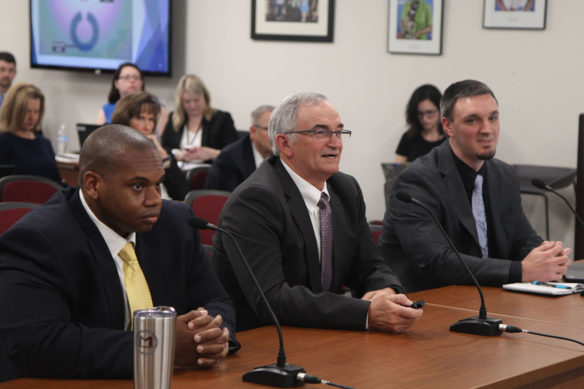
David Horseman, center, associate commissioner of the Kentucky Department of Education Office of Career and Technical Education and Student Transition, told a legislative task force July 10 that the top priority in developing a unified system for delivering career and technical education should be finding the best way to share the resources. Horseman and Kentucky Education Commissioner Wayne Lewis, left, called for a unified system when they addressed a legislative subcommittee July 9.
Photo by Megan Gross, Feb. 6, 2019
- Horseman gave lawmakers an overview of the state’s career and technical education system to the task force one day after the Kentucky Department of Education called for a unified CTE system.
- KDE is working to help districts combine their resources to better serve students regionally.
By Mike Marsee
mike.marsee@education.ky.gov
One day after the Kentucky Department of Education (KDE) called for a unified system for delivering career and technical education (CTE) in Kentucky, an associate commissioner told lawmakers the top priority should be finding the best way to share the resources that would go into that system.
While members of the Kentucky Career and Technical Education Task Force asked for recommendations from KDE for changes the Kentucky General Assembly might make and ways to fund those changes, Associate Commissioner David Horseman said the makeup of the system should take priority over the funding of it.
“We’re here from a first priority of getting the system right, what is best for the kids in our communities,” Horseman, who heads KDE’s Office of Career and Technical Education and Student Transition, told the task force at its July 10 meeting in Frankfort. “The first thing is to get our system the way it needs to be and learn to share what resources we have, and as money comes available we’d have a plan and a template to grow our system the way it needs to be.”
Horseman presented an overview of the state’s career and technical education system to the task force one day after he and Kentucky Education Commissioner Wayne Lewis told a legislative subcommittee the three ways the state currently uses to provide career and technical education (CTE) should be merged into a single system.
CTE is currently delivered through state-operated area technology centers (ATCs), locally operated career and technical centers (CTCs) and local area vocational centers (LAVECs) that receive supplemental state funding.
Horseman noted that about two of every three Kentucky high school students are enrolled in CTE career pathways. Of those pathways, 85 percent are connected to occupations within the state’s top five industry sectors, and 15 percent are connected industries that support those top five industry sectors.
He told the task force KDE is working to help districts combine their resources to better serve students regionally. Horseman said a regionally operated CTE center might not exist at a single location, but rather as a series of small hubs at several locations, each focusing on different career pathways.
“Let’s see where we are after we get districts together and sharing their resources,” he said. “Those are the kind of conversations that we believe need to be had among neighbors. Our schools are rivals on Friday nights on the football field, but we have to lay those (rivalries) aside and focus on Monday morning when the kids are there getting instruction,” he said.
Horseman said KDE has used the $2.1 million grant it received through the New Skills for Youth initiative to further regional delivery of CTE. The grant has led to the development of 10 regional career academies that involve employers in each of those areas. Each academy provides career pathways that have seamless transitions from secondary to postsecondary education and are aligned to the state and region’s most in-demand careers.
“New Skills for Youth is one of most transformational pieces we have had in the last three to five years,” he said.
The legislative task force, which next meets Aug. 21, consists of four members each from the Senate and the House of Representatives and a representative from the Education Professional Standards Board.
MORE INFO …
KDE officials call for legislators to create unified CTE system




Leave A Comment